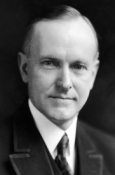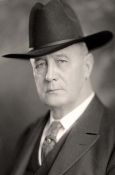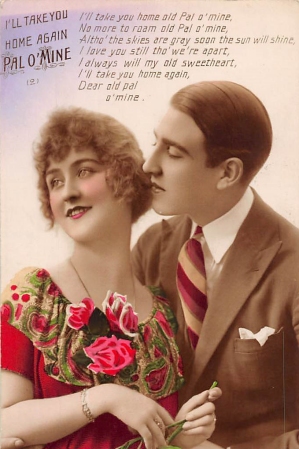
Regular Postage Stamps of the United States - 1925
Politics

President
Calvin Coolidge

Postmaster General
Harry S. New
Music

Click Control Above To Hear
1925 "I'll Take You Home Again"
Postage Rates
Domestic Letter Rate: 2¢ per oz.
Postal Card Rate: 1 ¢
Special Delivery Rate: 10¢
Postcard Rate: Jan. 1 - April 14: 1¢
Postcard Rate: April 15-Dec. 31: 2¢
Fractional Postage Rates Introduced (April 15): the rate for circulars was raised from 1¢ per oz. to 1½¢ per oz.
Air Mail Rate: 8¢ per oz. per zone - there were 3 zones (see: 1924 )
Although the Postal Service Act of Feb. 28, 1925 provided for a new "Private Contract Rate" of not less than 10¢ per oz.,
this service did not begin until 1926.
Registered Letter Fee: Jan. 1 - Apr. 14: 10¢ Apr. 15 - Dec. 31: 15¢(Postal Service Act of 1925)
Special Delivery Rate: Apr. 15, 1925 - 2-10 lbs. : 15¢ Over 10 lbs. : 20¢ (see below)
Special Handling Fee (Fourth Class): Apr. 15 - Dec. 31: 25¢(Postal Service Act of 1925) -
This gave a fourth class parcel the status of a first class letter (see below)
Stamps
The Fractional Denominations of 1925
400 Subject Plates (Unless noted otherwise)

1½¢ Harding Coil
Rotary Perf 10 Vertically 170 Subject Plates
First Day: March 19, 1925

1½¢ Harding
Flat Plate Perf 11
First Day: Mar. 19, 1925

1½¢ Harding
Rotary Press Perf 10
First Day: Mar. 19, 1925
Over 3 billion of the above stamps were issued. Records of printings for the individual varieties were not kept by the Bureau, but it is certain that fewer of the perf 10 stamps were saved by collectors than of the perf 11 or the perf 10 sidewise coil.

1½¢ Harding Imperforate
Flat Plate - First Day: April 4, 1925
27,226,000 issued (from Johl)

½¢ Hale - Perf 11 Flat Plate
First Day: April 4, 1925
Over 600 million issued

1½¢ Harding Vertical Coil
Perf 10 Horizontally - 150 Subject Plates
First Day: 5/9/25 - about 25 million
The Fractional Denominations
The one and one half cent Harding stamp was the first U.S. postage stamp issued in a fractional denomination; the one half cent Nathan Hale was issued about a month later. The 1½¢ value was issued to meet the new third class mail rate that went into effect April 15, 1925, while the ½¢ stamp was to be used with the ordinary one cent stamp to meet this rate. Both the 1½¢ and the ½¢ stamps were released early to provide ample distribution time to meet the new rates. Anticipating a great need, the Post Office rushed to print as many stamps of the new 1½¢ stamps as possible, issuing it in five philatelically important formats (see above). On the other hand, it was felt that the flat plate printings of the ½¢ stamp would meet demand and no other formats of that stamp were printed in the first year. In fact, the rotary press issues of the ½¢ stamp were not issued until 1929, four years later, and the imperforate and coil half cent stamps were never issued at all.
Partially in a rush to get this stamp into production and partially due to conflicts the engravers had with the designing of the Lexington Concord and Norse American commemoratives in the spring of 1925, it was suggested that the 2¢ black Harding Memorial commemorative design be used for the 1½¢ stamp, by changing the denomination from 2¢ to 1½¢, removing the "memorial" dates in the upper corners and changing the color from the "memorial" black. This is exactly what was done.
Both the half cent and the one and one-half cent stamp present something of an anachronism to the collector. They are both listed in the catalog well before the 2¢ black Harding memorial stamp, (Number 551 and 553 as opposed to the two cents Number lists as 610-612). In reality, they were issued more than a year and a half later and, as pointed out, the design of the 1½¢ stamp was taken directly from the 2¢ memorial stamp of 1923.
The 17¢ Woodrow Wilson "Memorial" Stamp - Dec. 28, 1925
Flat Plate - Perforated 11 - 400 Subject Plates - over 122 million issued
Designer: C. A. Huston - Engravers: J. Eissler (vignette) - E. M. Hall (frame & lettering) - J. C. Benzing (scrolls)

It's funny how time gives new faces to historical events. Woodrow Wilson, the war-time president who preceded Harding, died only about six months after Harding. The reader may remember that the Harding Memorial stamp was rushed into production within a month after Harding's death. At the time, Harding was a much more popular president than Wilson had been, and of course the Harding Memorial stamp had been well received by the public. Now it was Wilson's turn to be so remembered, but politics prevailed and the Wilson "memorial" stamp was put on hold, that is until the Harding Memorial stamp was altered to make the new 1½¢ stamp (see above). When this change was made, Democrats placed further pressure on the Post Office Department to issue a stamp memorializing Wilson. As it turns out a compromise of sorts was made. Wilson was not to be placed on a "memorial" stamp, but rather on a regularly issued definitive stamp. Since the rate to send a letter registered had been raised from 10¢ to 15¢, and combined with the letter rate of 2¢, 17¢ was now needed to send a registered letter. Wilson was placed on this seventeen cent stamp, and in further compromise the stamp was printed in the "memorial" black. However, the dates of the birth and death of Wilson were not included in the upper corners as had been done on the Harding Memorial stamp, in the tradition of other U.S. commemorative stamps.
The seventeen cent Wilson stamp is also something of an anachronism, in that it was issued before the thirteen cent stamp. Number lists the two stamps in denominational rather than chronological order, that is the thirteen cent Number 622 was issued after the seventeen cent Number 623.
Time has not been kind to Harding's legacy, linking his presidency to scandals that he may or may not have been aware of. Harding is often listed at or near the bottom of the list of U.S. Presidents. On the other hand, Wilson's status has only improved through the years and is now regarded by many as one of our nobler presidents.





